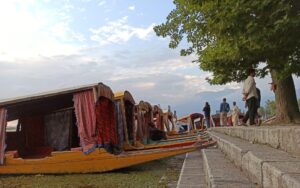Dal Lake’s Silent Plea
In an emotional plea to revive the declining houseboat industry, Ghulam Nabi Kinzou shares heartfelt insights into the craft's rich tradition and the urgent need to reconsider bans for the sake of Kashmir's heritage.
By Rehan Qayoom Mir
Amidst the captivating beauty of Dal Lake lies an untold narrative, intricately etched in wood and vibrant hues. Serving as an expansive canvas for the artistic mastery showcased in the iconic Shikaras and houseboats gracing its serene waters, the lake unveils a profound story.
In an exclusive conversation with a reporter, Ghulam Nabi Kinzou, a seasoned artisan from a lineage deeply rooted in crafting these wooden marvels, shared insights into his craft. “I’ve devoted the past 25 to 30 years to this art. Following in my father’s footsteps, I assumed the mantle of Shikara and houseboat craftsmanship. We produce around 10 to 15 types of Shikaras here, and the meticulous process takes approximately 20 days per Shikara,” revealed Ghulam Nabi.
Acknowledging the labor-intensive nature of his work, Ghulam Nabi expressed gratitude, stating, “It is a time-consuming and demanding process, but with the grace of Almighty Allah, our work flourishes.”
He emphasized the impact of tourism on his workload and highlighted the material challenges, noting, “We fashion our Shikaras from Deodar wood, incurring substantial expenses to transport materials to the secluded interiors of Dal Lake.”
“I’ve been working in this craft for the last 25 to 30 years. My father used to be involved in this craft, and after him, I took over this craft of Shikaras and houseboat making.”
Discussing government support, Ghulam Nabi advocated for controlled rates to facilitate their work, stating, “Regulating prices would ease our efforts, allowing us to continue our craft seamlessly.”
Despite his proficiency in crafting both houseboats and Shikaras, he lamented government restrictions that limit him to Shikara construction. Expressing a desire to diversify his work, Ghulam Nabi appealed to the government to reconsider the ban on houseboat construction, aiming to revitalize this rich tradition.

As previously reported by KNO, the decline of iconic houseboats is evident, with their numbers dwindling from 2000 to a mere 750, attributed to a blanket ban on construction and the scarcity of skilled craftsmen. Manzoor Pakhtoon,
President of the Houseboat Owners Association (HBOA), voiced serious concerns, recalling a time when nearly 2000 houseboats adorned Dal Lake, Nigeen Lake, and the river Jehlum in the early 1980s. “Today, the count has plummeted to just 750 in Dal Lake, Nigeen Lake, Chinar Bagh, and river Jhelum,” he lamented.
“As a houseboat is usually made out of Cedar wood, which can withstand damage from being in water for long periods, the houseboats usually have a corridor, drawing room, dining room, pantry, two to four bedrooms with attached bathrooms with hot and cold water.”
Highlighting the distinctive features of houseboats, Pakhtoon emphasized their construction from Cedar wood, known for enduring prolonged exposure to water. Describing their layout, he added, “Houseboats typically feature a corridor, drawing room, dining room, pantry, and two to four bedrooms with attached bathrooms equipped with hot and cold water.”
Suhail Yaseen, a houseboat owner at Dal Lake, echoed the growing concern, noting the rapid decline in their numbers. He underscored the scarcity of master craftsmen, urging the government to activate support for those remaining in the trade. As the number of houseboats dwindles, the plea for preservation resonates, ensuring that these once-revered “Crown of Kashmir” continue to grace the picturesque waters of Dal Lake.
The views expressed in this article are solely those of the author and do not necessarily reflect the opinions or views of this newspaper


Comments are closed.